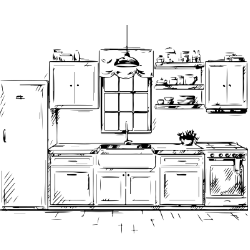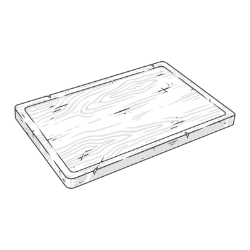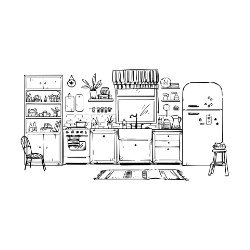
What Is the Correct Range Hood Height?

Having a range hood makes cooking a safer, more pleasant endeavor.
Without one, you'd have to crack open a window or door to filter out the exhaust and smells slowly.
But you can't just install it right above your stove however you want. You must follow a certain distance between your cooktop and the hood for it to work efficiently.
Let's find out the most optimal range hood height for every kitchen setup!
Recommended Range Hood Height/Distance
Generally speaking, the cooktop or countertop height in your kitchen doesn't really matter. The installation height of your range hood will depend on the type of range you have.
- Gas ranges: 24 to 36 inches
- Electric ranges: 20 to 24 inches
- Outdoor grills: 36 to 42 inches
NOTE: These are general averages. You should always check the manufacturer-provided range hood installation manual for the recommended installation height or distance for your specific model.

Depending on how much kitchen space you have and how tall you are, your range hood may have to be installed higher than the recommended maximum height.
After all, the distance between your range hood and stovetop should not get in your way while cooking. However, your range hood should never be installed lower than the recommended height.
That's because this minimum height limit has been determined by safety tests, as opposed to the upper limit, which is based only on performance.
A range hood installed too low will not only be inefficient but may also prove to be dangerous in the long run.
Again, the type of range you have is the most critical factor when choosing a range hood. But there are also other factors to consider.
Other Considerations
CFM (Cubic Feet per Minute)
CFM [1] is a measure of how much air the fan inside a range hood can circulate per minute. Basically, the higher the CFM, the more powerful a range hood is.

You can install lower-CFM range hoods at a lower height. These might be a good choice if you have an electric cooktop.
This stove type produces less smoke and hot air, so you do not need a powerful range hood to ventilate your cooking area.
On the other hand, higher-CFM range hoods can be installed higher up.
If you have a gas range or an outdoor stove, you should buy a high-CFM range hood.
These types of ranges produce lots of smoke and hot air, so you'll need a more powerful hood to vent all the exhaust and ventilate your entire cooking area.

One thing to consider is how much cooking you intend to do, as well as the kinds of food you'll be cooking.
- 100 – 400 CFM range hoods are considered standard-grade. If you cook relatively simple, easy meals, these are for you.
- 400 – 1,000-CFM range hoods are considered semi-professional-grade.
- Over 1,000-CFM range hoods are considered professional-grade. If you have a restaurant or professional, high-BTU gas range in your home kitchen, these are for you.
Your Kitchen Layout
In most conventional kitchen layouts, there are 3 places to install a range hood:
- On your wall (wall-mounted range hood)
- Underneath your kitchen cabinets (under-cabinet range hood)
- Over your kitchen island cooktop (island range hood)
How to Install Different Types of Range Hoods
Wall hoods and island hoods generally have a chimney pipe-type extension that draws the exhaust out through the ceiling.

Under-cabinet hoods usually draw the exhaust out through the wall. It's also essential to make sure you pick a hood with the proper duct size for your needs.
The Difficulty of Installing Your Type of Range Hood
Wall hoods and under-cabinet hoods are both supported on the wall by mounting brackets. Installation of these types of hoods is straightforward. All you have to do is drill the brackets into the wall and mount your newly bought range hood.
Island hoods, on the other hand, hang freely from the ceiling. Installation of these types of hoods is slightly more complicated.
First, you have to choose a spot where it's sure to be supported by the ceiling joists. Then you need to place extra support brackets before installing the chimney and hood.
Of course, the type of hood you choose will depend on your kitchen layout and available space.

But regardless of whether you pick a wall, under-cabinet, or island hood, always remember to follow the recommended installation height, depending on the type of cooktop you have.
Frequently Asked Questions
What if the Range Hood Is Mounted Too Far From the Cooktop?
Remember that the primary function of range hoods is to catch the fumes, soot, and grease particles released during the cooking process.
They contain a fan inside to draw the exhaust through the ceiling or wall and outside your house.
You cannot accomplish these if the range hood is placed too far from the cooktop area. Instead, you might have to deal with these issues.
It Reduces Your Hood's Efficiency: The effective capture area is where your range hood catches all the cooking fumes rising from the cooktop.
The extra few inches around the effective capture area will allow some of the exhaust to escape into your kitchen rather than going directly into the vent hood.
The Motor Will Wear Out Faster: Smoke and hot air expand as they rise. You'll most likely have to use it at a higher speed so it can vent the cooking fumes before they spread into your kitchen.
What if the Range Hood Is Mounted Too Close to the Cooktop?
Most experts will remind you not to mount your range hood close to the cooktop areas for safety and effectiveness.
Here are some negative effects that may happen if your range hood is installed right next to the cooktop.
You’ll Have to Clean the Hood More Often: Your range hood will catch more of the grease droplets and soot flying off of your cooking surface. Over time, this will stain the outside of the hood or build up into an ugly crust.
The Motor Will Wear Out Faster: Again, smoke and hot air expand as they rise. If the vent hood is too low, the motor will work harder to draw off the denser, hotter mass of air from your cooktop.
You May Damage the Hood: The intense heat coming from your cooktop may damage the electrical components in your range hood over time.
The Hood May Become a Fire Hazard: The ultimate worst case scenario is your range hood overheats and starts an electrical fire in your kitchen.
This could possibly happen if the electrical components have been degraded from frequent exposure to intense heat.
Conclusion
The correct installation height of your range hood depends on the type of range you have. For maximum efficiency in your kitchen, remember these recommended height ranges:
- If you have a gas range, install your range hood 24 to 36 inches above your cooktop.
- If you have an electric range, install your range hood 20 to 24 inches above your cooktop.
- If you have an outdoor grill, install your range hood 36 to 42 inches above your cooktop.
Besides the type of range, other factors in choosing a range hood include the cubic feet per minute and your kitchen layout.
Considering these criteria carefully will help you choose the best range hood for your specific kitchen needs.
Good luck installing your brand new range hood! You should be good to go as long as you follow all of our instructions and essential pointers.





